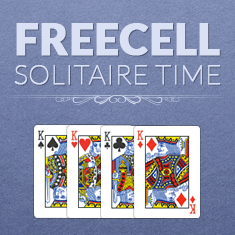Freecell Time
Addiction is a solitaire card game using 48 out of a deck of 52 playing cards. First, all 52 cards are laid out into 4 rows of 13 cards. Then, the Aces are removed and discarded from play. This leaves four gaps, four left behind by the Aces. Take that, freecell! One of the big problems is that freecell games are not at all randomly assorted, and so pencil and paper solutions aren't around. But lots of people have (surprisingly) cared about these questions, and so these results are all upper bounds. In short, about 45 moves is the average minimum. This Freecell game has a time limit, you get 10 minutes to clear the whole field. To make it extra exciting we left out the undo function.
Addiction is a solitaire card game using 48 out of a deck of 52 playing cards.First, all 52 cards are laid out into 4 rows of 13 cards. Then, the Aces are removed and discarded from play. This leaves four gaps, four left behind by the Aces.
The rule of the game are as follows:
- A gap can be filled by moving into it the card that is the same suit and a rank higher than the card on the gap's left.
- Nothing may be placed in a gap to the right of a King or another gap.
- Only 2s maybe be played in the left column.
- When no move is possible all cards that are not in suit sequence starting from 2 in the left column may be shuffled and replaced. You may do this up to 3 times.
The game is won when all 48 cards are arranged such that each row has 2 to King of the same suit in order starting in the left column.
 FreeCell is a solitaire game that was made popular by Microsoft in the 1990s. One of its oldest ancestors is Eight Off. In the June 1968 edition of Scientific American Martin Gardner described in his 'Mathematical Games' column, a game by C. L. Baker that is similar to FreeCell, except that cards on the tableau are built by suit instead of by alternate colors. This variant is now called Baker's Game.
FreeCell is a solitaire game that was made popular by Microsoft in the 1990s. One of its oldest ancestors is Eight Off. In the June 1968 edition of Scientific American Martin Gardner described in his 'Mathematical Games' column, a game by C. L. Baker that is similar to FreeCell, except that cards on the tableau are built by suit instead of by alternate colors. This variant is now called Baker's Game. Paul Alfille changed Baker's Game by making cards build according to alternate colors, thus creating FreeCell. He implemented the first computerized version of it for the PLATO educational computer system in 1978. The game became popular mainly due to Jim Horne, who learned the game from the PLATO system and implemented the game as a full graphical version for Windows. This was eventually bundled along with several releases of Windows.
Best Freecell Time
- Shuffle, then deal the 52 cards face up in 8 columns with each card visible but only the end card of each column fully exposed. Four columns will have 7 cards, the others only 6.
- Apart from the columns, there are four single card free cells and four suit piles (foundations). The objective is to get all the cards into the foundations.
- Single exposed cards may be moved:
- Column to column, placing the card on a card of the next rank and different colour suit. (E.G. Place a red 3 on a black 4.) (Aces are low.). Empty columns may be filled with any suit or rank.
- Column to FreeCell, any exposed card as long as there is an empty cell.
- FreeCell to Column, as column to column.
- Column to suit home pile. Next card in order, starting with the Ace, ending with the King. Each suit is completely independent.
- FreeCell to suit home pile. As column to suit home pile.